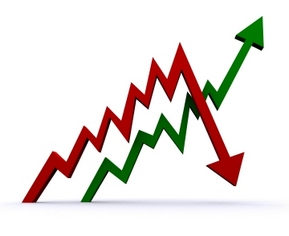 |
| Inflation vs Deflation |
Buried several hundred words deep in her post, Ejim (finally) opined that,
"Push on a string is a metaphorical reference to the fact that an object attached to a string can only be moved by moving the string away from the object. Pushing the string in the direction of the object will not have any effect on the position of the object."
We think it's utterly bizarre that Ejim thought the opposite of pushing a string is "moving the string away from the object." We mean, really? she'd never heard of pulling on a string? But, then, Esther seemed to have a lot of problems with definitions; not to mention a problem with attribution. According to Ejim,
"The term 'push on a string' is one that is attributed to John Maynard Keynes, a renowned British economist."
The grammatical quality of the sentence notwithstanding, "push on a string" and the idiomatically identical "push on a rope" long predate Keynes. Many sources cite U. S. Congressman T. Alan Goldsborough as the source when used in the context of macroeconomics. Be that as it may, Esther also had some problems with economic definitions (interesting for one who claims an MBA). Here's the line that tipped us off to that deficiency:
"A deflation is the opposite of inflation and means that there is a marked reduction in the demand for goods and services during consecutive business cycles."
First off, Esther, no one says "a deflation" (or, for that matter, "an inflation"). Second, "a marked reduction in the demand for goods and services during consecutive business cycles" is not deflation, it is a signal that deflation exists. While Ejim was correct that deflation is the opposite of inflation, she sidestepped the definition of deflation (per Investopedia):
"Deflation is a general decline in prices for goods and services, typically associated with a contraction in the supply of money and credit in the economy. During deflation, the purchasing power of currency rises over time."
Ejim also botched the standard monetary response to deflation (as well as Keynes' name):
"According to John Maynard Keyes [sic], the manipulation of the economy by the government through increased interest rates is no guarantee that the consumers will respond by increasing their demand for products."
|
Governments typically reduce interest rates as part of efforts to stave off deflation, not increase them. That's weird, because Esther later babbled about "low interest rates" in her closing statement, suggesting that our Dumbass of the Day simply parroted random blocks of text she did not understand. Pair that with her strange definition of deflation and her apparent ignorance of the antonym of "push," and Ejim has just picked up award number three.
NOTE: we were quite amused to notice that a computer-generated link near the end of Ejim's post will send readers to WiseGEEK's attempt to explain string theory (and not very well...) |
DD - ECONOMICS
No comments:
Post a Comment